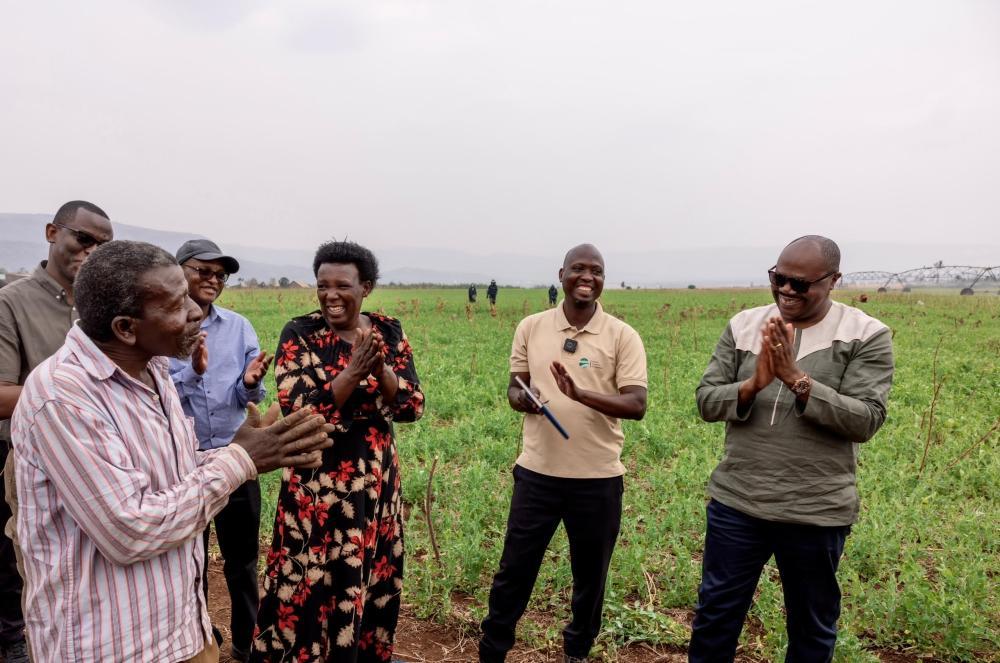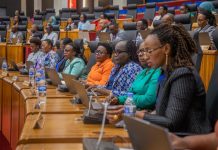Africa-Press – Rwanda. Violet Kansangire recalls how, about a decade ago, drought severely affected the livelihoods of residents in Nasho, Cyambwe Cell, Kirehe District. Families struggled to grow enough food and were often forced to migrate in search of sustenance.
The 57-year-old farmer owned 3.5 hectares of land, but drought had rendered it largely unproductive. That changed with the establishment of the Nasho solar-powered irrigation scheme, a project that she said has greatly improved farmers’ resilience to drought in one’s of Eastern Province’s drought-prone district.
The scheme, a joint venture between the government of Rwanda and the Howard G. buffet Foundation, is one of the agricultural initiatives that were toured by Prime Minister Justin Nsengiyumva on August 8.
Thanks to the irrigation project, Kansangire said she was able to significantly increase her farm yield and expanded her farmland to seven hectares.
“We used to go elsewhere just to find food, as our crops would fail due to the drought. Life was very difficult,” she said. “Now, I’ve expanded my land to seven hectares,” she said.
She now produces eight or nine tonnes per hectare, where production used to be just about two tonnes per hectare at best.
With these improved yields came financial stability. Kansangire has since built a house worth about Rwf40 million and purchased two vehicles, one family car and the other for transporting her farm produce.
“Buyers are scrambling for our maize,” she said, highlighting how year-round farming has put Nasho farmers at a greater advantage over those who still depend on rainfall.
Today, overall, farmers in Nasho testified that they are food secure and even provide agriculture-related jobs to residents from nearby communities, boosting local livelihoods.
Dierry Shyaka Nshuti, the manager of the Nasho Irrigation Cooperative – which groups the farmers who are the scheme beneficiaries – said the project spans over 1,100 hectares and supports more than 2,000 farmers.
“Before the irrigation scheme, yields were extremely low — a maximum of one tonne of maize per hectare. Now, we average 6.2 tonnes per hectare,” he said, adding that before the scheme, farmers were carrying out farming for only one season a year.
The project uses a combination of solar power infrastructure and pivot irrigation systems. Farmers primarily grow maize, green beans, soybeans, and chili, all of which have ready markets, he said, adding that the beans and chili are sold at the export market.
“We generate about Rwf1.4 billion annually from produce sales,” Nshuti added, pointing out that the project has had a positive impact on the community, including enabling farmers to pay school fees for their children.
During the visit, Prime Minister Nsengiyumva commended the farmers and pledged continued government support.
“We are backing you fully. Responsible government institutions are available to support you. This is an initiative we value deeply,” he said. “Don’t hesitate to ask for what you need. When you are food secure and doing well, we’re happy too.”
According to Rwanda’s fifth Strategic Plan for Agriculture Transformation (PSTA 5), which covers 2024/25 to 2028/29, the country aims to increase irrigated land from the current 70,000 hectares to 130,000 hectares by 2029. The goal is to build resilient and sustainable agri-food systems across the nation, according to the Ministry of Agriculture and Animal Resources.
For More News And Analysis About Rwanda Follow Africa-Press






